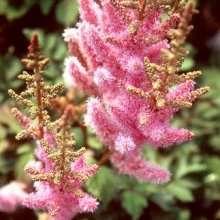Cut Flower Profiles
Chelone
Monday, March 14 | Cut Flower Profiles, Cut Flowers
Chelone is also called ‘turtlehead’ for the shape of its bloom. The botanical name Chelone comes from a Greek myth about a nymph of the same name who was disrespectful at the wedding of Zeus and Hera. As punishment, the nymph was turned into a tortoise and condemned to eternal silence (the tortoise was a Greek symbol of silence). There are several species of Chelone that are native to North America. The most common cutting variety, Chelone obliqua, is a favorite perennial among gardeners in our climate. As with all cut flowers, make sure to recut the stems and change the flower’s water regularly. Chelone is generally only available as a cut flower during the summer months....
Read More...Celosia
Monday, March 14 | Cut Flower Profiles, Cut Flowers
Celosia are generally available in two forms: Celosia cristata, the wrinkled, brain-shaped type and Celosia plumosa, the upright, feathery type. Celosia are available in a wide range of colors from pinks, burgundies, yellows and oranges. They are noted for their remarkable shape and fuzzy texture. The flowers are at their peak in the late summer to early fall months. ...
Read More...Bouvardia
Monday, March 14 | Cut Flower Profiles, Cut Flowers
Bouvardia was named after the personal physician to Louis XIII, Dr. Charles Bouvard. While bouvardia are native to Mexico, most of the plants used for flower production are grown under glass in Holland. Despite its lack of any appreciable fragrance, the bouvardia’s closest relative is the Gardenia. The flowers are particularly prone to dehydration so take extra care to re-cut your stems and change your vase’s water daily. Bouvadia are available in a range of colors from white to deep pink to a vibrant, scarlet red. ...
Read More...Astilbe
Monday, March 14 | Cut Flower Profiles, Cut Flowers
Originating in Asia, the astilbe is a member of the saxifrage family. Many varieties are perennials in our climate and make excellent additions to shadier areas of your cutting garden. The flowers are available in various shades of pink, red, purple, peach and white. Astilbe blooms are available year round and are very popular in wedding work. As with any cut flower, be sure to recut their stems and change the flowers’ water on a regular basis. ...
Read More...Allium
Monday, March 14 | Cut Flower Profiles, Cut Flowers
Flowering Allium belong to the onion genus along with about 1250 other species including chives, shallots and garlic. Members of this genus can vary in height from two inches up to five feet. Allium are generally found in temperate climates in the northern hemisphere, but some grow as far away as Chile, Brazil and tropical Africa. Our featured allium ‘Purple Sensation’ is winter hardy in our climate. The bulbs are generally planted late fall for early summer blooms (like tulips). As with all cut flowers, re-cut your alliums’ stems and change their water regularly for maximum vase life....
Read More...





